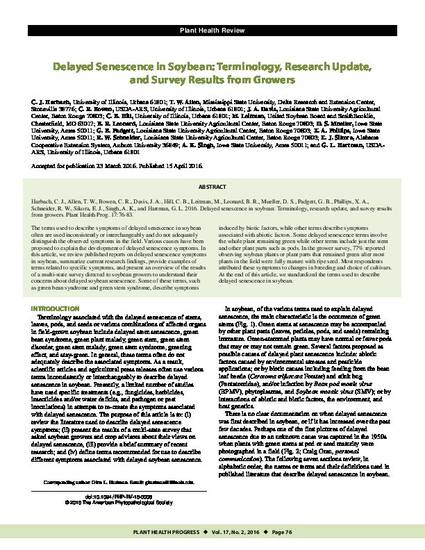
The terms used to describe symptoms of delayed senescence in soybean often are used inconsistently or interchangeably and do not adequately distinguish the observed symptoms in the field. Various causes have been proposed to explain the development of delayed senescence symptoms. In this article, we review published reports on delayed senescence symptoms in soybean, summarize current research findings, provide examples of terms related to specific symptoms, and present an overview of the results of a multi-state survey directed to soybean growers to understand their concerns about delayed soybean senescence. Some of these terms, such as green bean syndrome and green stem syndrome, describe symptoms induced by biotic factors, while other terms describe symptoms associated with abiotic factors. Some delayed senescence terms involve the whole plant remaining green while other terms include just the stem and other plant parts such as pods. In the grower survey, 77% reported observing soybean plants or plant parts that remained green after most plants in the field were fully mature with ripe seed. Most respondents attributed these symptoms to changes in breeding and choice of cultivars. At the end of this article, we standardized the terms used to describe delayed senescence in soybean.
Available at: http://works.bepress.com/asheesh-singh/21/

This article is published as Harbach, C. J., Allen, T. W., Bowen, C. R., Davis, J. A., Hill, C. B., Leitman, M., Leonard, B. R., Mueller, D. S., Padgett, G. B., Phillips, X. A., Schneider, R. W., Sikora, E. J., Singh, A. K., and Hartman, G. L. 2016. Delayed senescence in soybean: Terminology, research update, and survey results from growers. Plant Health Prog. 17:76-83. doi: 10.1094/PHP-RV-16-0008. Posted with permission.